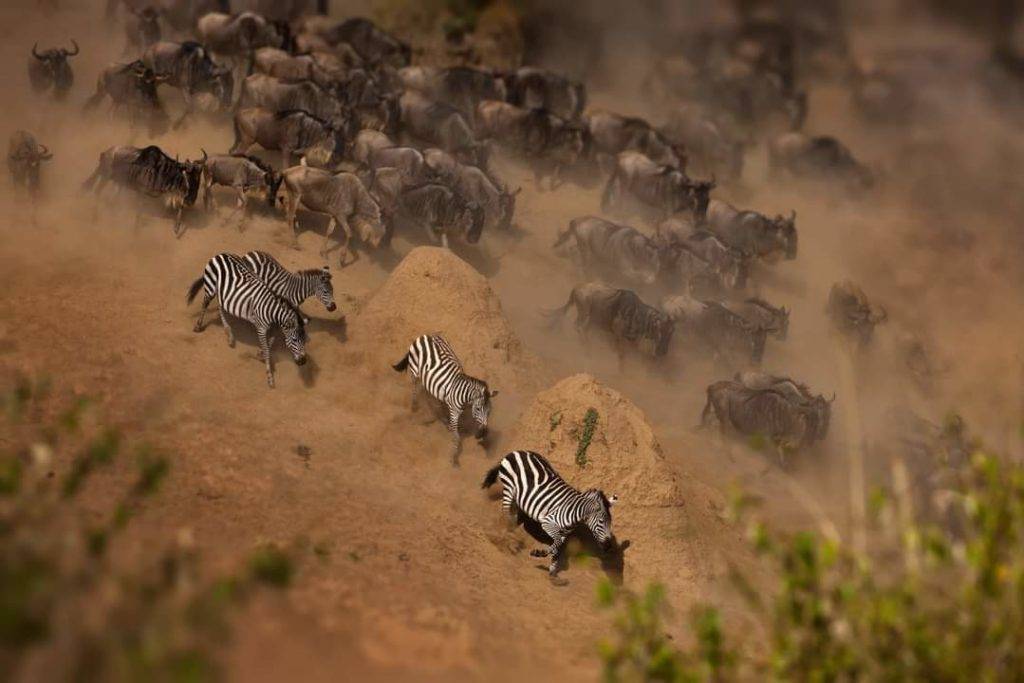
What is Tanzania Famous for ? : Exploring the Country's Famous Wildlife and Landscapes
Nestled along the eastern coast of Africa, Tanzania is a captivating canvas painted with the hues of nature’s grandeur and cultural diversity. As travelers tread its landscapes, a question echoes in their minds: What is Tanzania famous for ? This East African gem has etched its mark on the global stage, beckoning explorers with the promise of untamed wilderness, breathtaking vistas, and a rich tapestry of traditions.
Tanzania’s fame is inseparable from its wildlife wonders. The Serengeti National Park, a sprawling expanse, hosts the awe-inspiring Great Migration, a natural spectacle where herds of wildebeests traverse the savannah in pursuit of greener pastures. The iconic Mount Kilimanjaro, Africa’s tallest peak, adds another layer to Tanzania’s allure, challenging climbers and offering sweeping views from its snow-capped summit. Yet, beyond these natural marvels lies a cultural mosaic, where diverse ethnic groups coalesce, each contributing unique traditions, languages, and customs to the nation’s identity. Join us as we unravel the enigma of what is Tanzania famous for, immersing ourselves in the charm of its wildlife, the majesty of its landscapes, and the warmth of its people.
Here is the list of what Tanzania is famous for;
1: Tanzania's famous national parks and wildlife reserves
Walk on the wild side in Tanzania, a country known for its awe-inspiring wildlife and breathtaking landscapes. From the iconic Serengeti National Park, home to the annual wildebeest migration, to the snow-capped peaks of Mount Kilimanjaro, Tanzania offers a paradise for nature enthusiasts and adventure seekers alike. With its diverse habitats, including the Ngorongoro Crater and the mystical Mount Meru, Tanzania is teeming with an abundance of wildlife, such as lions, zebras, elephants, and giraffes.
Embark on a thrilling safari and witness the circle of life unfold before your eyes, as predators and prey coexist in perfect harmony. Discover the unique walking safaris in the Selous Game Reserve or go chimpanzee tracking in the dense forests of Gombe Stream National Park, made famous by renowned primatologist Jane Goodall.
But Tanzania’s allure extends beyond its wildlife. Dive into the depths of the turquoise waters of Zanzibar, explore the rich cultural heritage of Stone Town, or unwind on the pristine white sand beaches.
Whether you are seeking adventure, relaxation, or a deeper connection with nature, Tanzania offers an unforgettable experience that will leave you in awe of its famous wildlife and landscapes.

2: The Great Migration in Serengeti National Park
The Great Migration is one of nature’s most incredible spectacles and a highlight of any visit to Tanzania. Each year, more than a million wildebeest, along with thousands of zebras and gazelles, embark on a journey that spans over 1,800 miles in search of fresh grass and water. This epic migration is driven by the changing seasons and the need for survival. The wildebeest face numerous obstacles along the way, including treacherous river crossings and predation by fierce predators such as crocodiles and lions.
Witnessing the Great Migration is a once-in-a-lifetime experience. Imagine standing on the vast plains of the Serengeti, surrounded by a sea of wildebeest as far as the eye can see. The thunderous sound of hooves and the dust kicked up by the herds create a surreal atmosphere. It’s a mesmerizing display of nature’s power and resilience.
To make the most of your Great Migration experience, consider timing your visit between July and October, when the wildebeest gather in the northern Serengeti in preparation for their daring river crossings. This is the perfect opportunity to witness the raw drama of predator-prey interactions and capture some truly remarkable photographs.

3: Exploring the Ngorongoro Crater
The Ngorongoro Crater is a geological wonder and a haven for wildlife. Formed by a massive volcanic eruption millions of years ago, the crater is now a self-contained ecosystem that supports a remarkable diversity of flora and fauna. Its sheer size and natural beauty make it one of Africa’s most iconic destinations.
Descending into the crater is like entering a different world. The lush greenery and the shimmering blue waters of Lake Magadi create a picturesque backdrop for the abundant wildlife. The crater is home to an estimated 30,000 animals, including the densest population of lions in Africa. Spotting these majestic creatures in their natural habitat is an experience that will stay with you forever.
While exploring the Ngorongoro Crater, keep an eye out for the endangered black rhino. The crater is one of the few places in Africa where these magnificent creatures can still be found. Witnessing these ancient giants up close is a humbling experience and a reminder of the importance of conservation efforts.
To make the most of your visit to the Ngorongoro Crater, consider staying at one of the lodges located on the crater rim. Not only will you enjoy breathtaking views, but you will also have the opportunity to witness stunning sunrises and sunsets over the crater.

4: Mount Kilimanjaro - Africa's highest peak
For those seeking an adrenaline-pumping adventure, look no further than Mount Kilimanjaro. As the highest peak in Africa, reaching an elevation of 5,895 meters, Kilimanjaro attracts climbers from around the world. Scaling this majestic mountain is a test of physical endurance and mental fortitude, but the reward is incomparable.
There are several routes to choose from, each offering a unique experience and varying levels of difficulty. The Marangu Route, also known as the “Coca-Cola Route,” is the most popular and relatively easier compared to other routes. The Machame Route, on the other hand, is more challenging but rewards climbers with stunning views and a greater sense of accomplishment.
As you ascend the mountain, you will pass through different climate zones, from lush rainforests to barren alpine deserts. The ever-changing landscapes and the sense of isolation will leave you in awe of nature’s wonders. And when you finally reach the summit, standing on the “Roof of Africa,” the feeling of triumph and the panoramic views will make all the effort worthwhile.
It’s important to note that climbing Mount Kilimanjaro is not for the faint of heart. Proper preparation, including physical training and acclimatization, is essential. Hiring an experienced guide and porters is highly recommended to ensure a safe and successful climb.

5: The stunning beaches of Zanzibar
After exploring Tanzania’s wildlife and landscapes, it’s time to unwind and relax on the stunning beaches of Zanzibar. This tropical paradise, located just off the coast of mainland Tanzania, offers pristine white sand beaches, crystal-clear turquoise waters, and a vibrant marine ecosystem.
Zanzibar is famous for its idyllic beach destinations, such as Nungwi, Kendwa, and Paje. Whether you prefer lounging on a sunbed, swimming in the warm Indian Ocean, or indulging in water sports such as snorkeling or scuba diving, Zanzibar has something for everyone.
One of the highlights of Zanzibar is the Stone Town, a UNESCO World Heritage Site and a melting pot of cultures. Wander through the narrow alleys lined with ancient buildings, visit the bustling markets, and immerse yourself in the rich history and vibrant atmosphere. Don’t forget to try the local cuisine, which is a fusion of African, Arab, and Indian flavors. From spicy curries to freshly caught seafood, the culinary delights of Zanzibar will tantalize your taste buds.

6: Cultural experiences in Tanzania
Tanzania is not just about its wildlife and landscapes; it’s also a treasure trove of cultural experiences. Immerse yourself in the local way of life and discover the rich cultural heritage of the Tanzanian people.
Visit a Maasai village and learn about their traditional way of life. The Maasai people are known for their vibrant clothing, intricate beadwork, and their close relationship with nature. Spend time with the villagers, listen to their stories, and participate in traditional dances and ceremonies. It’s a chance to gain a deeper understanding of their customs and traditions.
Another cultural highlight is the vibrant music and dance scene in Tanzania. From the rhythmic beats of traditional drumming to the energetic moves of the Maasai jumping dance, Tanzanian music and dance are a celebration of life and joy. Attend a live performance or even take part in a dance workshop to experience the infectious rhythm firsthand.

Best time to visit Tanzania
The best time to visit Tanzania depends on the specific experiences you seek. Generally, the dry season, from June to October, offers excellent wildlife viewing opportunities, as animals gather around water sources. This is also the prime time for witnessing the Great Migration in the Serengeti.
For bird enthusiasts, the wet season, from November to May, is the ideal time to visit, as migratory birds arrive in Tanzania. The lush green landscapes and the vibrant colors of the birds create a stunning spectacle.
It’s important to note that Tanzania’s climate varies significantly depending on the region. The coastal areas, including Zanzibar, have a tropical climate with high humidity and temperatures ranging from 25 to 30 degrees Celsius throughout the year. The highlands, such as Mount Kilimanjaro and the Ngorongoro Crater, have a cooler climate, with temperatures dropping as you ascend.
Final words
Tanzania unfolds as a captivating nation, far more intriguing than initial impressions might suggest. Behind its exterior lies a wealth of fascination, from a compelling history to a captivating culture, all set against a backdrop of breathtaking landscapes. These are just glimpses into the wealth of remarkable facts that define this African country.

Meet Allano, the founder of Active Wonders Safaris Tanzania, a tour company dedicated to crafting transformative safari adventures for more than a decade. Allano, hailing from Tanzania, nurtured a profound connection to the region’s cultures and customs since childhood.
Join his odyssey and discover the essence of the African Safari encounter.


